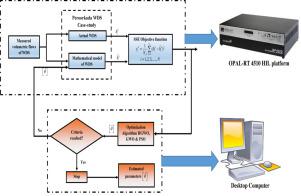当前位置:
X-MOL 学术
›
Control Eng. Pract.
›
论文详情
Our official English website, www.x-mol.net, welcomes your feedback! (Note: you will need to create a separate account there.)
Dynamic soft sensor based parameters and demand curve estimation for Water Distribution System: Theoretical and Experimental cross validation
Control Engineering Practice ( IF 4.9 ) Pub Date : 2020-09-01 , DOI: 10.1016/j.conengprac.2020.104544 S. Sankaranarayanan , N. Sivakumaran , T.K. Radhakrishnan , G. Swaminathan
Control Engineering Practice ( IF 4.9 ) Pub Date : 2020-09-01 , DOI: 10.1016/j.conengprac.2020.104544 S. Sankaranarayanan , N. Sivakumaran , T.K. Radhakrishnan , G. Swaminathan

|
Abstract The ostensive process of each Water Distribution System (WDS) is manipulated by the hydraulic parameters such as dimensional features, working state of the system components and the demand profile of the end user. In general cases, the access of those factors is unobtainable due to the shortage of sensors and more capital expenditure on the measurement methods. In such circumstances, the crucial parameters have been foreseen with the obtainable measurements of WDS, which are often contaminated with measurement noises. In this study, a hybridized version of metaheuristic based Grey Wolf Optimization (GWO) is proposed using static Kalman Bucy (KB) mechanism as Hybridized Grey Wolf Optimization (HGWO). This proposed hybridization suppresses the effect of measurement noises over the parameter estimation. Further, to make the HGWO adaptable for any fault occurrence or dynamical changes, a statistical based fault diagnosis is also proposed. To assess the efficiency of the proposed algorithm under fault occurrence situation a synthetic WDS system considered as the first case study, where faults purposely injected into the system and performance of the estimation algorithm studied. The second case study is from eastern WDS section from Peroorkada town, Trivandrum City, India given by Kerala Water Authority (KWA) consists of 110 unknown parameters and 6 unobservable demand profiles. The credibility of estimation algorithm also tested in the Hardware in Loop platform (HIL) for field applications. For both the case studies, parameter estimation is carried out using and compared with the related algorithms, viz., Particle Swarm Optimization (PSO) and GWO. The obtained result shows that the proposed HGWO provides better estimates of the factors and the unobservable states for both the case studies.
中文翻译:

基于动态软传感器的配水系统参数和需求曲线估计:理论和实验交叉验证
摘要 每个配水系统(WDS)的明示过程受水力参数控制,例如尺寸特征、系统组件的工作状态和最终用户的需求概况。在一般情况下,由于传感器的短缺和测量方法的更多资本支出,这些因素是无法获得的。在这种情况下,关键参数已经通过 WDS 的可获得测量值预见到,这些测量值通常会受到测量噪声的污染。在这项研究中,使用静态卡尔曼布西 (KB) 机制作为混合灰狼优化 (HGWO),提出了基于元启发式的灰狼优化 (GWO) 的混合版本。这种提议的混合抑制了测量噪声对参数估计的影响。更多,为了使 HGWO 能够适应任何故障发生或动态变化,还提出了基于统计的故障诊断。为了评估所提出算法在故障发生情况下的效率,将合成 WDS 系统视为第一个案例研究,其中故障有意注入系统并研究了估计算法的性能。第二个案例研究来自印度特里凡得琅市 Peroorkada 镇的 WDS 东部部分,由喀拉拉邦水务局 (KWA) 提供,包括 110 个未知参数和 6 个不可观察的需求概况。估计算法的可信度也在硬件在环平台 (HIL) 中进行了现场应用测试。对于这两个案例研究,参数估计是使用相关算法进行并与相关算法进行比较的,即粒子群优化 (PSO) 和 GWO。
更新日期:2020-09-01
中文翻译:

基于动态软传感器的配水系统参数和需求曲线估计:理论和实验交叉验证
摘要 每个配水系统(WDS)的明示过程受水力参数控制,例如尺寸特征、系统组件的工作状态和最终用户的需求概况。在一般情况下,由于传感器的短缺和测量方法的更多资本支出,这些因素是无法获得的。在这种情况下,关键参数已经通过 WDS 的可获得测量值预见到,这些测量值通常会受到测量噪声的污染。在这项研究中,使用静态卡尔曼布西 (KB) 机制作为混合灰狼优化 (HGWO),提出了基于元启发式的灰狼优化 (GWO) 的混合版本。这种提议的混合抑制了测量噪声对参数估计的影响。更多,为了使 HGWO 能够适应任何故障发生或动态变化,还提出了基于统计的故障诊断。为了评估所提出算法在故障发生情况下的效率,将合成 WDS 系统视为第一个案例研究,其中故障有意注入系统并研究了估计算法的性能。第二个案例研究来自印度特里凡得琅市 Peroorkada 镇的 WDS 东部部分,由喀拉拉邦水务局 (KWA) 提供,包括 110 个未知参数和 6 个不可观察的需求概况。估计算法的可信度也在硬件在环平台 (HIL) 中进行了现场应用测试。对于这两个案例研究,参数估计是使用相关算法进行并与相关算法进行比较的,即粒子群优化 (PSO) 和 GWO。


























 京公网安备 11010802027423号
京公网安备 11010802027423号